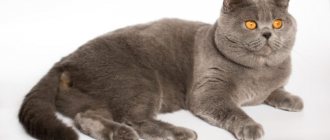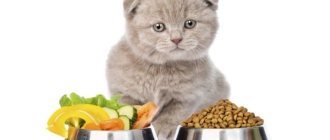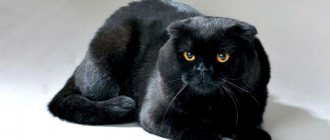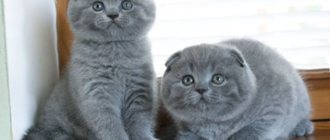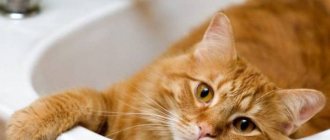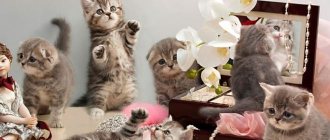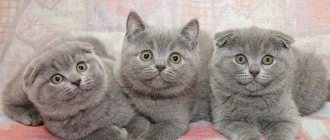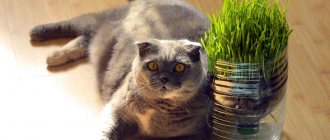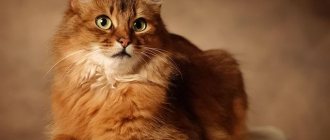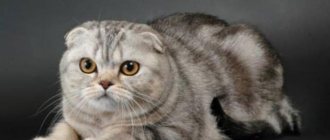Is it possible to breed a Scottish cat with a Scottish cat?
There is one caveat. Sometimes folds' ears stand up. Sometimes this happens so quickly that an illiterate breeder does not have time to identify them as folds. Or the cats end up with new owners, and because of their straight ears, they think that they bought straight cats. As a result, they will breed their cats as straight cats, that is, with folds. But the lop-eared gene has not gone away: it simply did not appear visually. And then the offspring will be from two folds, that is, probably terminally ill. That’s why you can crossbreed only males and females that have documents of origin (metrics, pedigree), where their breed is indicated. However, in any case, it is better to castrate cats and cats with erect ears, even if they have documents.
Why can't you cross two fold-eared animals?
The occurrence of lop ears in cats is associated with a random mutation in one cat on a farm in Scotland back in 1961. The white fold cat was registered and became the first fold cat of this breed. After this incident, scientists began working on developing a new breed of cats with folded or lying ears.
Over time, modern geneticists have come to the conclusion that the gene that gives cats lop ears is dominant. This suggests that in the process of passing genes from parents to children, one gene responsible for the shape of the ears must be lop-eared. In this case, the kitten will have flat ears. But in the case when both parents have both genes responsible for the shape of the ears, the kitten will be born homozygous for lop ears (that is, with the same genes in a pair). This is a big disadvantage in its further development - there is a very high risk of problems with bone development.
Thus, the lop ear gene can lead to a homozygous development of the kitten. This property is the main reason why scientists do not recommend crossing lop-eared individuals with each other. Only the connection between a straight-eared and a fold-eared kitten will allow you to produce healthy fold-eared kittens in a litter (50% of the litter has this gene).
That is, the answer to the question of why it is impossible to bring two lop-eared animals together is the following theory: all owners of lop-eared ears contain this gene, which is responsible for the bending of the ears. And if you cross two lop-eared individuals, then kittens with numerous diseases and problems will be born.
Today there are many unscrupulous breeders who, despite all the warnings, specifically breed two fold-eared kittens, since fold-eared kittens are much more expensive than straight-eared ones. The problem is that kittens from such a litter can be born seemingly healthy, and after one or two years the disease will make itself known. People who commit such mating are outright sadists!
Stories from breeders of fold cats
The other day I met a woman who firmly stated that she had been mating a cat and a cat with fold ears for 8 years. The terrible thing is that she knows about the consequences of such a mating and she is absolutely not ashamed of it! Leaving it to chance, she stated that she had no problem with it. I decided to check.
I took the kitten from this woman and went to the veterinary clinic for diagnostics. A routine X-ray revealed serious genetic mutations. The kitten's bones have fused incorrectly! The structure of the ridge mutated, the tail did not bend at all due to its hardness. The veterinarian concluded that this kitten would live no more than two to three years. Having shown the veterinarian’s report to the kitten’s owner, I was surprised by her behavior. She snatched the poor animal, declared that all this was not true and closed the door.
Be carefull! Pay attention to reviews and recommendations when choosing a fold-eared kitten. You can also have your kitten examined by a veterinarian.
But it’s not just about the correct mating to produce healthy lop-eared offspring. There are cases when genetic mutations can occur under other circumstances, for example, “it didn’t grow together.” This is nature!
The main goal of professionals is to produce healthy offspring with minimal risk of genetic mutations.
How to choose a healthy fold-eared kitten?
First of all, pay attention to the recommendations of nurseries. But keep in mind that it is impossible to predict genetic diseases in purebred cats! After all, all mammals are born healthy, and what awaits them next is unknown. Love your pets and they will thank you back!
Preparing for the event
In order for mating to be successful the first and any subsequent time, you need to properly prepare for it. Both animals are pre-treated for parasites, including worms. It is advisable to vaccinate the male against diseases such as chlamydia and rabies.
When a breeding partner has been selected and mating dates have been approximately determined, the premises are prepared. The room in which the Scotsman will be with the cat must be dry, bright, clean and spacious. It must be warm inside.
Copulation of pets can last several days. Therefore, the cat should be packed for the trip. She must come to visit her partner with her property: bowls for water and food, a tray with filler, food, toys, etc. Due to the fact that the female often shows aggressiveness, she needs to trim her claws before mating. These are the main conditions for successful mating.
When a Scottish Fold cat is in heat (first day), she is taken to the cat. Before mating, you need to check the male and female cat again for the presence or absence of discharge from the eyes, nose or ears, or dandruff. Pets must have sufficient body weight. If deviations from the norm are detected, the mating is postponed. A domestic cat usually covers a female 14 times during the day. After a few days the cat loses interest in him.
Scottish fold kittens, genetic features
To preserve the breed qualities of cats, it is advisable to use purebred breeding. At the same time, it is important to correctly select breeding sires. Cats with exterior defects or genetic abnormalities should not be allowed to mate.
- At the same time, there is a great variety of cat breeds in color, pattern and coat length. Absolutely all the characteristics and properties of cats are determined by genes, responsible not only for color and pattern, but also for eye shape, temperament, body type, length, etc.
- The karyotype (2p) of domestic cats consists of 38 chromosomes, of which 36 are autosomes and 2 sex chromosomes (xx in cats and xy in cats). Hundreds and thousands of genes are located in strictly defined regions (loci) on each chromosome.
- The coloring and patterns of fur in all cats without exception are hereditary. They come in all colors except green: black, white, brown, cream, red (of various shades), blue, gray. (See Predicting Color When Crossing Cats)
- Cats also have a variety of coat patterns (tiger, marbled, spotted, with markings on the face, paws, tail, etc.). However, getting a cat of one color or another is not as easy as it seems. It all depends on the genes that control the color and pattern of the coat.
- Some colors dominate over others (for example, black over blue, red over cream), others, determined by recessive genes, appear only in a homozygous recessive state, i.e., as a rule, with inbreeding (lilac, light brown, etc.) , others are inherited in a sex-linked manner (red, red).
- When selecting pairs for crossing, it is important to take into account the relationship between dominance and recessivity. So, if a cat and a male cat have a dominant trait, all of the offspring (or 3/4 of them) will also have it. If a female and male exhibit a recessive trait, then all offspring will inherit it.
In cases where a cat with a pronounced recessive trait mates with a cat that has a dominant trait, and all offspring inherit it from the mother, then the cat is homozygous for the dominant gene.
However, if half of the offspring exhibit a dominant trait and the other half exhibit a recessive trait, we can conclude that the cat is heterozygous and carries both dominant and recessive genes.
According to the color and coat pattern, cats can be smooth-haired (Persian, Angora, Norwegian Forest, British, Oriental Shorthair, etc.), two-color (American Shorthair, Maine, Scottish Fold, Ragdoll, etc.), variegated (Turkish, Angora, exotic shorthair, Japanese short-tailed), multi-colored (chocolate tortoiseshell, lilac-tortoiseshell Burmese, American wirehair, etc.), speckled cats (chinchilla, blue smoky Persian, red and tan American), tabby with combined and Siamese colors (cream Persian, blue Abyssinian, Burmese, Siamese, etc.).
- When breeding cats, it is necessary to remember that individual genes that determine coat color are located on the X-sex chromosome and, therefore, their inheritance is sex-linked. This inheritance has its own specifics.
- According to D. Silkstone Richards (1994), crossing tortoiseshell cats with various solid (black, red, blue, cream) or bicolor males does not guarantee the production of at least one tortoiseshell kitten. Cats with a tabby pattern should not be used for breeding either, as they can pass on unwanted stripes and markings to their offspring.
- Hair length in cats is inherited according to the type of dominance of short-haired T (LL) over long-haired (11) with splitting according to G. Mendel and the formation of genotypes in the ratio ILL: 2L]: 111. Sometimes intermediate inheritance in hair length occurs in heterozygotes of type L1.
- Cats, like people, have different blood types that are not always compatible with each other. There are three known types in cats - A, B and AB, which vary greatly in frequency of occurrence in different breeds depending on the original areas of origin.
- The most common type of blood is A, all cats of eastern origin have it (Siamese, Orientals, Burmese, Tonkinese), as well as Russian Blues, almost all (93-98%), Norwegian Forest and Maine Coons. Among Persians, Abyssinians, Burmese, Somalis, Scottish Folds and Sphynx cats, the incidence of type A blood ranges from 80 to 89%.
Among exotics, British Shorthairs, and Cornish Rex - only 60-79%. The remaining animals, as a rule, have blood type B. Type AB is very rare and has been little studied, but it is known that physiologically it is close to type A.
Genetic type A is dominant over type B, and when homozygous animals (that is, representatives of “pure lines”) of two types are crossed, the offspring will have type A, but will be a carrier of type B, which can be detected in subsequent generations. Crossing two representatives of the B-type always produces only B-offspring.
Everything would be fine, the blood type itself does not in any way affect the condition and health of the cat, but there is an incompatible combination during mating that threatens the death of the offspring: this is the crossing of a type A cat with a type B cat, or, in other words, type A kittens are incompatible with their mother type B.
Unlike humans, in cats, as in other animals, maternal antibodies incompatible with the fetus do not penetrate the placenta, thus, kittens in this case are born normally, but the ill-fated deadly antibodies are contained in mother's milk, secreted in the first hours after childbirth - in the so-called colostrum. If an A-type kitten born from a B-cat feeds on mother’s milk, especially for the first 16-20 hours, it receives ready-made antibodies with it, including those that work against its own blood cells.
Proper organization of mating
The rules for mating Scottish cats consist of the following points:
- Mandatory vaccinations and treatment against parasites are carried out at least 15 days before mating.
- Cats must be healthy, free from infectious foci and open wounds.
- It is necessary to trim the animals' claws so that they will not be able to inflict deep scratches on each other.
- You should not pre-bathe your pets so as not to disturb their natural scent.
- At least a week before the intended mating, cats are not given medications (especially hormonal ones).
Pet owners also need to decide on whose territory the Scottish breeding will take place in order to prepare the premises. Traditionally, the cat plays the role of “master,” but this issue can be discussed.
Optimal age for breeding a Scottish cat
The age of feline puberty is 6–9 months. During this period, the female experiences her first estrus. But the animal is still in adolescence, the formation of the body is completed only at the age of one year.
A one-year-old Scottish cat has a formed skeleton; hormones that control reproductive function stop growth processes in the body.
In this regard, mating during the first heat is not recommended, otherwise the cat will not grow to normal breed dimensions and its body will remain small. Experienced breeders advise mating Scottish Folds on the third heat, when the female is already mature and fully formed.
Scottish cats that have received high exhibition scores are allowed for breeding. Preparing a fold-eared kitten for an exhibition begins after vaccinations and quarantine, and the pet can only wait until it is 1.5–2 years old to be allowed to breed.
Is it possible to breed a fold-eared cat with a fold-eared cat?
Once we figured out the hereditary genetics, it became clear why it is impossible to breed two fold-eared Scots. It's all about the corresponding lines that form within the group:
Bad consequences occur when a couple with lop-eared inclinations is crossed with each other. Any of them gives the kittens one gene each, the FdFd formula is combined, and the cub’s body receives the entire set of hereditary ailments.
What pets can be crossed
At the end of the selection, clear recommendations for breeding were given. Violation of the instructions will certainly lead to a recurrence of hereditary diseases.
Genetically, animals must belong to different groups:
- Descendants of FdFd from two fold-eared parents cannot take part in breeding matings at all and are rejected from the breed.
- Kittens from a pair of carriers of the straight-eared gene fd are born with normal ear structure. They can be mated with both pendant and straight-eared dogs.
That leaves the final group Fdfd. In such a pair, one of the parents is lop-eared, and the other is straight-eared. Kittens are born mixed - half inherit the characteristics of the mother cat, and the second - the father.
Who can this breed be crossed with?
In this breed there are cats and cats of two varieties: fold-eared - with curled ears and straight-eared - with erect ears.
Important: Throughout life, the ears of lop-eared dogs may straighten a little, while those of straight-eared dogs may bend slightly, but this does not in any way change the type of breed they belong to. In this regard, there are errors when indicating the breed in animal passports, and it is important to keep this in mind when choosing partners for mating.
Only fold-eared and straight-eared people can be confidently matched. In this case, the offspring will be genetically healthy. About half the kittens will be of the fold-eared variety, and half will be of the straight-eared variety.
It is risky to mix Scots with outbred cats, as well as with cats of any other breeds. The offspring can be either healthy or have health problems of varying severity.
You cannot reduce:
Important: A Scottish Straight cat can easily be mistaken for a British Shorthair, which cannot be crossed with.
It is best if the cat is selected by the breeder from whom the cat was adopted. An experienced cat is more desirable than one that has never bred. It is correct to bring a cat to a cat, and not vice versa.
Features of pregnancy in fold-eared cats
The course of pregnancy in lop-eared females differs from other representatives of the cat family.
Due to the calm nature of this species, there are no mood swings, bursts of aggression, or isolation. The mother carries the kittens for approximately nine weeks. At the end of the mating, the animal calms down, becomes affectionate, and willingly makes contact with members of the household.
Pregnancy can only be determined after two or three weeks. The nipples change color, swelling and a more pink tint are observed. However, these signs are characteristic only of young animals; in older cats - older than three years of age - such signs may not appear.
Pregnancy can be determined after two to three weeks.
First half
The first half of pregnancy is characterized by increased appetite.
At this stage, fish feeding should be stopped to avoid the destruction of B vitamins, as they contribute to the normal development of embryos. It is necessary to increase the amount of food containing calcium: dairy and lactic acid products in the form of cottage cheese, milk, sour cream, kefir, yogurt.
Cottage cheese will be useful for a cat in the first half of pregnancy.
Second half
The second half passes calmly and only further growth of the abdomen and an increase in overall weight are observed.
In the second half of pregnancy, growth of the abdomen is observed.
It will be possible to determine the number of fold-eared and straight-eared kittens only after twenty-two days. At the first stage, the entire brood looks exactly the same, and they cannot be distinguished.
Third week
By the end of the third week, the cartilage begins to mature and strengthen, and everything falls into place. In Fold kittens, the ears curl even more and bend towards the head, while in Straights they gradually straighten.
By the end of the third week, kittens' cartilage begins to strengthen.
Scottish Fold (Scottish Fold cat)
For such representatives of the canine family, such as the Rottweiler, collie and Labrador, pug and fox terrier and many others, various forms of lop ears are not surprising, which cannot be said about cats. Fold cats, original in their kind, quickly won the attention of cat lovers. Thanks to this, the rather rare Scottish Fold has ceased to be a rarity, and has become not only very common, but also “reproduced”, which is something that lovers of purebred pets are somewhat unhappy about.
Genetics of Scottish cat colors
Scottish fold cats come in different colors; to get kittens of the desired color you need to choose parents with knowledge of genetics:
- In order for a Scottish kitten to turn out red or cream, the coat of both the male and female must be the required color.
- Dominant colors (white, black, smoke, tabby, bicolor, chinchilla) are passed on from parents to offspring, not through generations.
- A Scottish kitten with a dominant color has at least one dominant parent.
- If both dad and mom have a recessive color (cream, blue), then they will not have a single dominant cub.
- A cub with a light undercoat must have a parent with the same undercoat.
- A Scottish chinchilla kitten must have at least one parent with this coat (or tabby). And a tabby baby must have at least one tabby (or chinchilla) parent.
- A chinchilla cat can give birth to smoky offspring, but a smoky cat cannot become the mother of chinchilla kittens.
- A bicolor Scottish kitten must have one of its parents bicolor.
- To produce a color point litter, both mom and dad must be this color.
The owners are responsible for the success of mating and the health of their pets. It is important to choose the right individuals, prepare a comfortable place for them, and minimize stress. Inexperienced owners should consult with breeders and breed club specialists before organizing mating.
Source
What is the owner of the male responsible for?
Before inviting a Scottish cat for mating, the owner of the male must know some rules so that the whole process does not lead to psychological and physical injuries .
- If animals have difficulties, they need help.
- Some animals can show aggression, therefore, at the slightest problem, it is better to postpone all mating actions. Maybe after a while the cats will get used to each other.
- Upon arrival at your destination, it is best to keep the cat in its portable vehicle for a while. Let her get used to it, sniff it, rest and gain strength.
- If animals are too aggressive, it is better to place them in enclosures so that they can get used to each other.
Possible difficulties
Mating is not always completed successfully. Possible problems:
- The cat didn't get pregnant. I'll have to knit it again.
- The female does not allow the gentleman to approach. In this case, the owner either strokes the area of her external genitalia or injects a drug that causes ovulation. The last resort is the use of a vaginal probe. Although it is usually enough to give the cat time to groom.
- The opposite problem happens: the cat is not interested in the guest. There is only one way out - to find another cat to breed.
- An inexperienced gentleman may cling his teeth to his girlfriend’s withers too high or low, and then the sexual process may turn out to be uncomfortable. Sometimes the cat falls on its side. In these cases, the owner helps the pets, carefully and gently correcting the position of their bodies.
Preparing a cat for surgery and the postoperative period
You can no longer feed 12 hours before surgery, and drink 3 hours before!
It is important to choose a trusted clinic where professionals operate. The cat is no longer given food 12 hours before surgery, and water 3 hours before surgery. Anesthesia on a full stomach leads to vomiting, and the falling asleep animal may suffocate.
The operation to remove a cat's testicles is performed under general anesthesia and takes about half an hour.
A castrated cat wears a collar after surgery
A small suture is placed on the incision and treated with an antiseptic; the cat is put on a special collar so that it cannot reach the suture and damage it. During recovery from anesthesia, the cat is placed in a warm place on thick bedding and a waterproof diaper, because uncontrolled urine loss is likely.
In the first hours, the cat needs constant observation: it will try to get up and move independently on its spreading legs, and the owner’s task is to prevent the pet from being injured due to a sudden, clumsy movement.
It is necessary to monitor the condition of the cat’s suture: if inflammation, swelling or bleeding appears, you should definitely see a veterinarian.
During the first day after surgery, the cat requires careful supervision.
Usually within a day the purr finally comes to its senses and begins to eat. It is better to give him liquid and low-fat food with a drop of Vaseline oil to start peristalsis, since after castration cats may experience slight constipation.
But, if the cat has not passed out for three days, this is a serious symptom that requires seeing a doctor.
If the operation was carried out correctly, then within a day, rarely later, the cat’s signs of hunting completely disappear, activity returns and interest in games increases.
Pros of castration
After castration, the cat will ask to be held more often, and his character will change for the better.
- The cat's character changes for the better: the aggression and anxiety inherent in an animal in heat disappear, the cat becomes more affectionate, obedient and playful.
- He stops yelling at night and marking his territory (not always).
- He does not try to run outside in search of a cat and will not leave offspring (approx. sometimes a castrated cat can impregnate a cat), which will meet a sad fate.
- Neutered cats live longer and are not at risk of reproductive diseases.
Disadvantages of castration
After castration, a cat may become obese
- Some cats gain weight after castration and become like “couch cushions.”
- Such cats can no longer be fed as before; they require special ready-made food, which, as a rule, is not cheap.
- Due to weight gain, heart disease and urolithiasis, as well as diabetes, are likely.
- Not all cats tolerate anesthesia well; complications are possible.
- Castration of cats is irreversible (unlike tubal ligation in cats), and it is important for owners of purebred animals to take this into account.
Breeds of potential partners
Scottish fold cats are bred within the breed. Interbreeding is unacceptable; it leads to anatomical and physiological abnormalities of the offspring. Even if the kittens are born healthy, they will be mixed breeds that cannot be sold at a decent price.
Scottish fold cats are descendants of their British relatives. Until 2004, “Scots” and “British” were considered one breed, and matings between these two varieties were allowed. But when the Scottish breed became independent, with its own breed standards, interbreed matings were banned.
The prohibition of crossing with British relatives is associated with:
- Deterioration in appearance, disappearance of Scottish Fold breed characteristics, including ears adjacent to the head.
- The appearance of skeletal abnormalities in the offspring associated with weakening of cartilage tissue. Scottish pets have a light skeleton and an elongated spine. And in British individuals the skeleton is heavier and more massive. Offspring are born with twisted limbs or backs.
NOTE! Mating of Scottish and British cats is practiced, but in extremely rare cases, under the strict control of the phenological service. The result must be recorded in the nursery's breeding journal.
Why you can’t cross two fold-eared cats
Crossing a fold-eared cat with a fold-eared cat is unacceptable; the problem lies in the genetic characteristics of the breed. The result is highly likely to be the birth of sick offspring.
And the culprit for this will be the lop ear gene, designated Fd. It is dominant, which means that when paired with the reverse gene, it still leads to the appearance of droopy ears.
But the problem is that this gene also negatively affects the condition of the joints. If he creates a pair with a similar gene, then the resulting offspring will most likely have serious skeletal pathologies, depriving them of a full life, causing lameness, and pain when moving.
Therefore, a fold-eared individual (Scottish Fold) can only be mated with a straight-eared one (Scottish Straight).
If both individuals are Scottish Straight, then mating should not cause concern, since they carry the recessive fd gene, which does not affect the condition of the skeleton. But the kittens will be born with straight ears and will cost less.
Background of the breed
It all started in 1961, when in the agricultural province of Scotland, a simple barn cat, Susie, was discovered to have a natural ear mutation. The tips drooped toward the head, giving the round-headed animal an “owl-like” appearance.
Later, this unusual Scottish cat gave birth to two identical fold-eared cubs:
- The boy was soon castrated.
- The fold-eared girl was named Sans; she was acquired by William Ross, who lived next door, a cat lover who planned to start breeding a new breed.
Susie herself was soon hit by a car.
It so happened that the success of the entire experiment depended only on Sans. Several partners were selected for her from among the British Shorthairs and outbreds, the first matings were carried out and as a result she received 76 kittens, of which 42 inherited the maternal trait.
At that moment, no one had yet wondered why it was impossible to cross a fold-eared cat with the same cat. Experimenters began creating pairs - bringing together kittens from different litters from different fathers in order to avoid direct inbreeding (mating brothers and sisters).
Now all newborns had the characteristic sign of bent ears in their appearance (it appears by the end of the 3rd week). But along with the developed tips of the auricle, kittens without exception acquired additional negative consequences in the form of diseases of the joints, bones, fusion of vertebrae, arthritis, and arthrosis.
It got to the point that the registration of the Scottish Fold breed was canceled, and work on its selection stopped for a while.
Then the whole process moved from Europe to the American continent. There they realized that two fold-eared Scots cannot be brought together into one parental pair, but they decided to try a different method.
The breeders again took the fold-eared girl, selected her partners from the local short-haired breed, got mixed offspring (fold-eared and straight-eared), and then geneticists got involved in the work and began conducting tests on the influence of various traits on the process. As a result, it was scientists who saved these cats from complete oblivion.
Childbirth among Scots
Let's look at when and how labor begins in a Scottish Fold cat. The first signs of labor in a cat are brownish vaginal discharge.
The behavior of a cat often changes before giving birth: the animal is looking for a place (nest) to give birth, screaming and making attempts, especially if the Scottish female gives birth to kittens for the first time. In such a situation, it is worth staying close to the cat, calming it down and caressing it, and if necessary, helping, delivering the cat’s birth. Kittens are born head first.
Newborn kittens weigh about 100 grams and are a bubble filled with light yellow liquid. After the kittens are born, the mother chews this bladder, releases the cub and licks it to cleanse the lungs. You can help her with this by suctioning the fluid from her nose with an enema while the female gives birth to other kittens.
Kittens come out at intervals that last about 20 minutes, however, the cat can independently increase the duration of labor and delay the appearance of the babies and carry them for another day if something does not suit her or frightens her. After the young mother has been able to give birth to a kitten, the afterbirth comes out.
A Scottish cat will give birth to approximately 2 to 4 kittens the first time, but in general they will give birth to 1 to 8 kittens.
Kittens open their eyes a week after birth. All Scottish kittens are born with straight ears, and only at 3 weeks of age should you pay attention to the ears; in folds, they begin to droop.
Mating rules
To successfully breed a Scottish Fold cat, owners must follow the following rules:
- Mating occurs on the third day of estrus, when the probability of successful fertilization is highest.
- The cat is sent to the cat, and not vice versa. The male will feel confident in his native territory.
- The female is taken to mating with her tray and usual food. The pet will feel familiar smells, making mating less stressful for her.
- The cat is left with the gentleman for 2–3 days, since mating usually does not occur on the first day. Animals need to be given time to get to know each other.
- For pets you need to prepare a separate room or fenced area.
IMPORTANT! Animals that have had cancer are not sent for breeding. In cats, malignant tumors are often hereditary and can appear in offspring. Also, sudden hormonal fluctuations can cause a relapse of cancer cell growth.
First mating
Mating for the first time and subsequent times in Scottish cats follows approximately the same pattern:
- The cat is slowly approaching the cat. The female scares away the gentleman, hissing at him, rushing with her claws.
- The male behaves with restraint and caution, pretending that he is not interested in the guest. Then the cat, wanting to attract attention to itself, begins to toss and turn, lying on the floor, meowing invitingly.
- But as soon as the boy shows interest, the girl becomes aggressive again. And so on several times.
- Then the cat gives in and allows the gentleman to approach her.
- The male climbs onto the female and grabs her by the withers with his teeth.
- Sexual intercourse in cats is short, lasting about 10 seconds. It ends with ejaculation of the male and the cry of the female.
- The cat runs away from his girlfriend. And she lies down on her side and begins to spin around with satisfaction.
